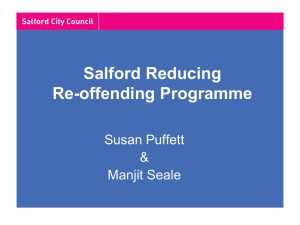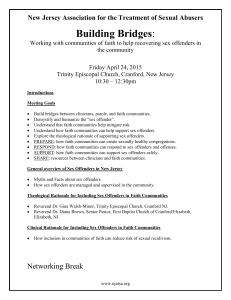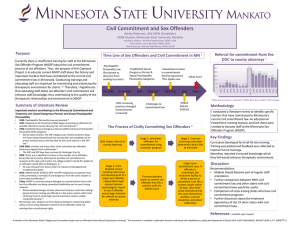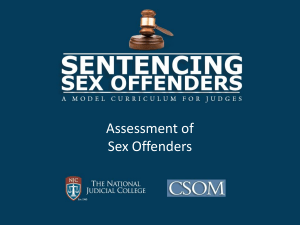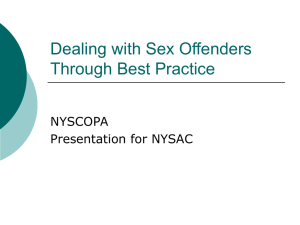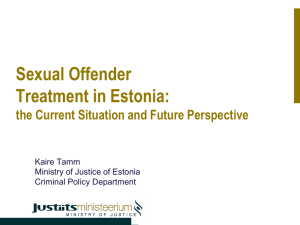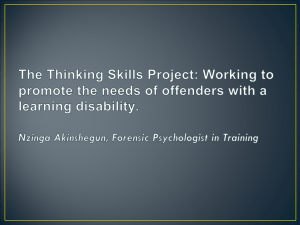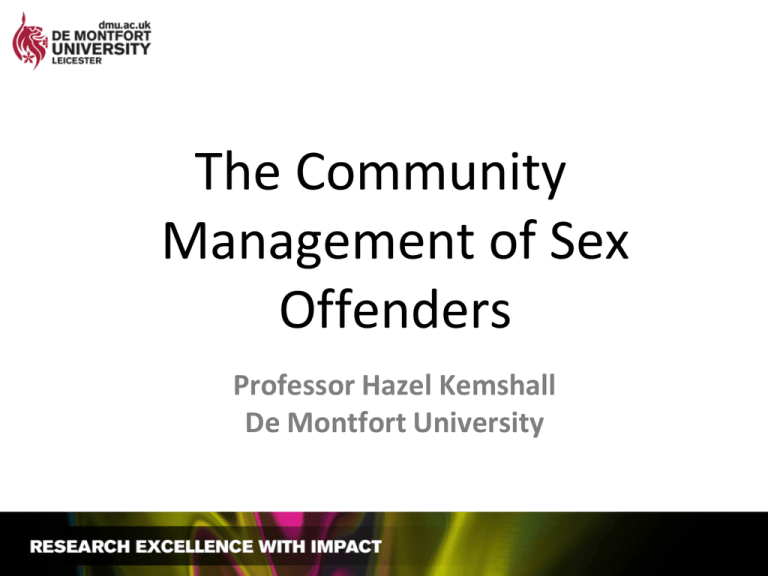
The Community
Management of Sex
Offenders
Professor Hazel Kemshall
De Montfort University
Going to focus on...
• Achieving balance in Risk Management Plans.
• What works? Particularly potential contribution
of GLM.
• Understanding reluctance to change.
• Multi agency contribution to RMPs.
Background
• HMIP inspections and requirement for ‘balance’ and
more ‘holistic’ risk management plans.
• Desistance research and literature, including on high
risk sexual offenders.
• A ‘strengths’ agenda, building networks, enhancing
protective factors.
• Austerity - be lean not just mean.
• Re-introduction of professional judgement.
• Dealing with risky behaviours rather than ‘providing
things’.
Risk Management: Key
Principles
•
•
•
•
•
•
Proportionate
Defensible
Lawful
Non-arbitrary
Balanced
Evidence-based
• Transparent and
open to scrutiny
• Recorded,
communicated and
accountable
The Four Pillars of Risk
Management
Supervision
Monitoring Interventions
and control and treatment
Victim
safety
Risk Management Planning
4 key activities:
• Supervision, monitoring and control, interventions
and treatment, victim safety planning, and
• Sufficient to manage the risk
• Appropriate to offender and his/her situation
• Relevant to risk factor(s)
• Evidence based
• Least restrictive necessary
Source: RMA 2007; Kemshall et al 2010.
The Four Pillars of Risk
Management
• Supervision
• Structured and focused contact, set at a frequency commensurate with
risk.
• Intensive supervision-focusing on problematic behaviours, encouraging
compliance, strengthening protective factors.
• Supervised accommodation.
• Monitoring
• Electronic tagging.
• Surveillance.
• Use of local police intelligence about offending networks.
• Documentation of early warning signs.
• Understanding of behaviours and events which require close monitoring.
• Communication arrangement between all parties.
The Four Pillars Cont.
•
•
•
•
•
Intervention / Treatment
Identification and intensive one to one work on key triggers.
Development and rehearsal of self-risk management techniques.
Appropriate programmes.
Medication.
•
•
•
•
•
•
Victim Safety Planning
Information and education of known and potential victims.
Contingency measures.
Emergency contacts.
Appropriate support personnel.
Restriction of access to victims.
(RMA 2007; Kemshall 2011).
What works? GLM and sexual
offenders
• Using a strengths based approach.
• Balancing the legitimate needs of the offender with the prevention of
risk.
• Promoting internal controls and desistance.
• Promoting offender engagement, and a 'humanistic' relationship between
worker and offender.
• Avoiding totally 'deficit focused' assessments and interventions- this
echoes Attrill and Liell's offenders who stated that: 'it's just pure negative
that people look at, not the positives' (2007).
• Supporting change and being motivational.
(For a review see H. Kemshall (2010))
A moment of reflection
• Do you find it hard to think of sexual and violent offenders you are
working with as having strengths? How do you characterise them
'in your own mind'?
• Do only ever talk about risks and not about legitimate needs?
• How would you characterise the style of your supervisory
relationship with these offenders? Humanistic? Punitive?
Stigmatising?
• Think about your last discussion with a sexual or violent offenderwhat was the balance between 'deficits' and strengths in your
discussion? Were you overly focused on one or the other?
• What practical things have you done to support change?
The important protective factors
• Enhanced sense of personal agency.
• Stronger internal locus of control (and therefore more
capacity for self-risk management).
• Can find positive outcomes even in negative events.
• They react positively to treatment (e.g. often
describing treatment as a 'turning point').
• They find a place in a pro-social and non-offending
network.
Farmer, M. and Beech, T. (2007); Barnett, G. D. and Mann, R. E. (2011)
Holistic Risk Management
External
Internal
Motivation
Risk
Some important questions for us
• Do we assess motivation, capacity and
ability to change as well as we assess risk?
• Do we (and can we?) incentivise as well as
control?
• Do we focus on problematic behaviours?
• How well do we understand reluctance to
change?
Dealing with ‘reluctance’
• Reluctant
• Rebellious
• Resigned
• Rationalising
(Farrow et al 2007).
Risk management plans that target
problematic behaviour
Problematic sexual
behaviour
• Consistent enforcement of rules
• Censure do not reward
• Programme re aggression and
violent fantasies/behaviour
• Rehearsing alternatives
• Victim safety plan
• Monitor for key escalation signs
• Behavioural agreements
• Protective factors
Discussion on problematic behaviours
• List the key problematic • List your responses and
behaviours here
interventions here
Job
Centre
+
Police
Probation
Mental
Health
Children’s
Safeguarding
LEAD AGENCY
RISK
MANAGEMENT
PLAN
Housing
Victim
Contact
Prison
YOS
Kemshall, H (2012)
Review and Revise
• If it isn’t working it isn’t working!
• Changes must be positive and real.
• Respond to deterioration and negativity.
• There have to be gains for the offender
no matter how small.
Thank you for listening!
For further information or permission to use
this material please contact Professor Hazel
Kemshall on:
01905 641 632 or kemshall@dmu.ac.uk
References
•
•
•
•
•
•
•
•
Barnett, G. D. and Mann, R. E. (2011) Good Lives and Risk Assessment: Collaborative Approaches to Risk
Assessment with Sexual Offenders. In: Kemshall, H. and Wilkinson, B. (eds.) Good Practice in Assessing Risk:
Current Knowledge, Issues and Approaches. London: JKP.
Farmer, M. and Beech, T. (2007) Assessing desistance in child sexual abusers: a qualitative study. Farmer, M.
and Beech, T. (2007) Assessing desistance in child sexual abusers: a qualitative study. Unpublished manuscript
Farrow, K., Kelly, G. and Wilkinson, B. (2007) Offenders in Focus: Risk, responsivity and diversity. Bristol: Policy
Press.
H. Kemshall (2010) The role of risk, needs and strengths assessment in improving the supervision of offenders.
In: F. McNeill, P. Raynor and C. Trotter (eds.) Offender Supervision: New directions in theory, research and
practice. Willan.
Mann, R. E., Hanson, R. K. and Thornton, D. (2010) Assessing risk for sexual recidivism: Some proposals on the
nature of psychologically meaningful risk factors. Sexual Abuse: A Journal of Research and Treatment, Vol. 22,
pp. 172-190.
Ward, T., Collie, R. M. and Burke, P. (2009) Models of Offender Rehabilitation: The Good Lives Model and the
Risk-Need-Responsivity Model. In: Beech, A., Craig, L. and Browne, K. (eds.) Assessment and Treatment of Sex
Offenders: A Handbook. Chichester: Wiley-Blackwell.
Ward, T. and Mann, R. (2004) Good Lives and Rehabilitation of Sex Offenders: A Positive Approach to
Treatment. In: Linley, A. and Joseph, S. (eds.) Positive Psychology in Practice. New York: John Wiley.
Ward, T., Vess, J., Collie, R. M. and Gannon. T. (2006) Risk management or goods promotion: the relationship
between approach and avoidance goals in treatment for sex offenders. Aggression and Violent Behaviour, Vol.
11, pp. 378-393.




